First ride: 2017 BMW S1000R Sport review
For 2017 BMW’s super naked has lost weight and gained power, but there's more to it than that
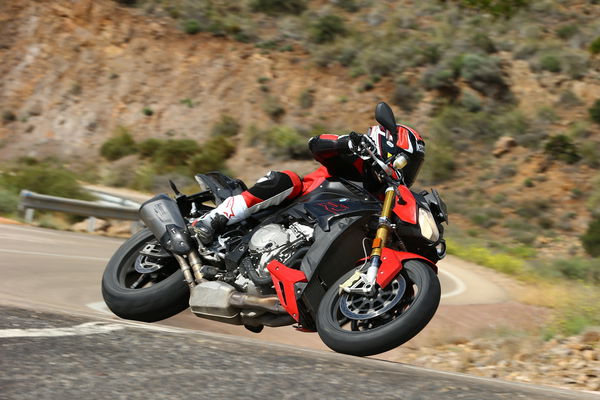
MORE POWER, less weight. Is there a better phrase in motorcycling?
Of course not. Thankfully BMW is on the same page as me, which is why the 2017 S1000R makes 5hp more power (up to 165hp) and at 205kg, has dropped 3kgs thanks to a lighter frame.
I know those numbers might be small, but every little counts; they go towards making the S1000R an incrementally better bike. So do the rest of the changes it’s received this year, such as a quick-shifter that works up and down the ‘box, plus cornering ABS, lighter forged wheels and a new Akrapovic exhaust can as standard.
During a day spent jumping between the new BMW R nineT Pure and R nineT Racer, also I rode the S1000R Sport, which is £12,365 on the road. It’s the one with that comes with all the toys, including electronic suspension, cruise control, heated grips, quick-shifter and cornering ABS.
That means the BMW is the cheaper than the new Yamaha MT-10 SP (£13,399), and comes with a longer spec sheet plus more power. Compared to another recent super naked from Europe, the KTM 1290 Super Duke R, the S1000R Sport is down on power by 9hp, but it’s cheaper than the £13,399 KTM and equipped with a more extensive spec list out of the box.

Visually, very little has changed. Thanks to a reduction in the size of the plastics either side of the radiator, a little more of the engine is visible, but that’s it. To look at, it’s still compact and razor sharp, with an unchanged front end. To my eyes, thanks to the front lights, the S1000R wears the look of an unhinged, homemade-knife-fashioning cellmate.
As striking as the styling is, the first thing to grab my attention is the deep sound that growls out from the ugly Akrapovic silencer as the bike idles. Get moving and the S1000R sounds awesome, with an angry inline-four engine sound. Best of all is the stuttering whirr it briefly emits when the throttle is first closed - it reminds me of the sound made by BMW’s old WSB race bike with its traction control cutting in.
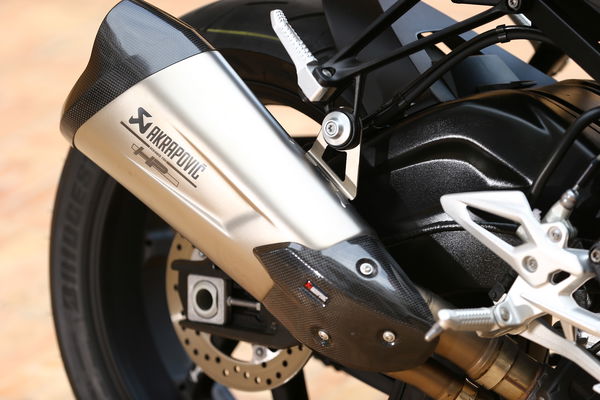
The fierce exhaust sound is matched by a savage turn of speed from the engine. I’ve ridden the previous S1000R and it’s impossible for me to pinpoint the additional 5hp, but I can vouch for how ultra-smooth the engine is…
… But a smooth engine isn’t exactly the sexiest compliment to pay a heavy-hitting super naked. Well how about the fact that it’s a motor that has such a complete spread of perfectly-delivered power that it’s difficult to pick out a highlight? The engine is strong everywhere. It’s got it all – heaps of torque through the rev range, plus an exciting top end rush. Whether you’re bumbling around under 6,000rpm or trying to break the shift light as you chase the 11,00rpm redline, the engine always feels like it’s giving you its best.
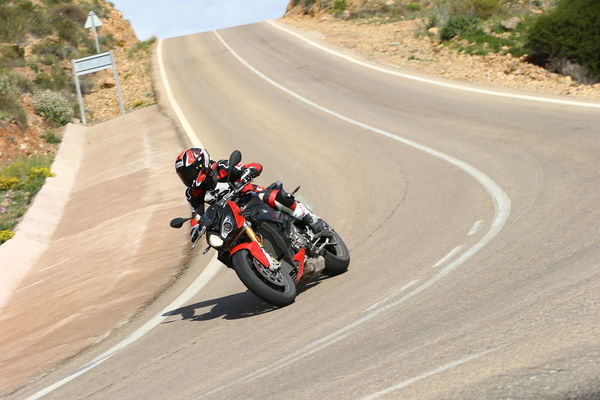
Simply put, the S1000R is blisteringly, effortlessly, and clinically fast. In fact, it’s so smooth and effortlessly quick that at times I only realised how fast I was going when my neck muscles began to burn with the effort of supporting my head and clinging on become more of an effort. The only criticism I can levy at the S1000R’s engine is that it’s not quite as fun as the short-geared lump in the Yamaha MT-10; the BMW just coolly gets on with the business of going fast.
Good job the brakes are excellent. Well, still excellent. The stoppers on the 2017 bike haven’t changed, so the front wheel is still graced by a pair of Brembo four-piston monoblocs that provide sharp initial bike, one-finger stopping power and superb feel, much like the brakes on the Aprilia V4 Tuono. Take note, Yamaha.
The bike I rode also had BMW’s ABS Pro system. That’s cornering ABS to you and I. When the roads of the launch ride weren’t soaking wet, they were dusty and slippery and although I never squeezed the lever in a bend, it was nice to know that I had the option, should I need it. On track, I’ve no doubt it’s something that could bail me out of trouble.
THE S1000R'S up-and-down quick-shifter (which gets the catchy name ‘Gear Shift Assist Pro’) is the best I’ve ever used. It’s fantastically smooth and offers quick and precise changes regardless of which direction you left boot is going. It never faltered for me throughout the day. It’s as if it was engineered by Nasa. Or Germans.
There’s electronics to be found in the suspension too – the S1000R uses BMW’s Dynamic Damping Control system. The suspension will give you different damping, depending on what riding mode you’ve got selected. Select Rain mode, for example, and along with the softer throttle response, you’ll get softer damping control. My bike had the optional ‘Riding Modes Pro’ pack, which gives it a ‘Dynamic’ mode, for track riding and allows for a user customised mode.
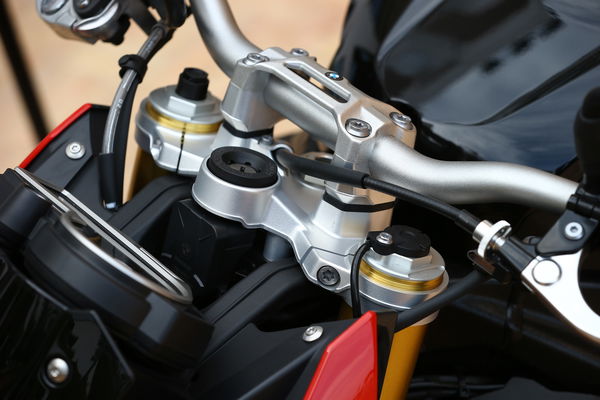
Alongside the Rain and Dynamic riding modes sits Road. Dynamic delivers the most direct ride. Flicking between the three affects power delivery, traction control and ABS intrusion, along with damping settings. Switching to Rain delivers the most noticeable change – the suspension softens, as does the throttle response and the traction control is easily provoked, to the point where it can cut power quite harshly. Having said that, I was glad of it during the biblical rains that plagued much of the launch ride, but I should stress that regardless of the conditions or how fast I was going, the S1000R was always predicable and assured.
BMW can also supply you with a dongle that provides a Dynamic Pro mode, which will let you back off the traction control even more.
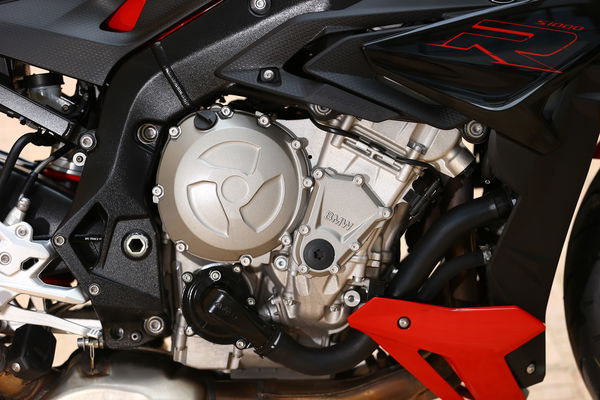
Switching between modes is easy using the controls on the right switchgear and damping settings can be adjusted using a button on the other side of the bar. It’s all intuitive and the layout of the information on the dash means that you don’t need to delve into and scroll though endless menus to adjust simple things.
Regardless of what mode I’d selected, the S1000R delivered a superb connection to the road. It’s not the comfiest bike I’ve ever ridden – the seat is firm and at one stage I got a stern jolt over a bumpy section of road but a naked version of the S1000RR is not meant to be an armchair. As such, this is a bike that turns with precision and a distinct lack of effort; a few inputs through the wide, easy-to-reach bars, a shift of body weight, and I was lightly into a corner.
The ride position is well set for attack. The handlebar might be higher than the S1000RR’s clip-ons, but I wasn’t sat straight backed, more a little leant forward – a comfy enough position and one that works really well when you want to go faster.
You won’t be surprised to learn that new BMW S1000R Sport picks up where the old one left off. It’s a fantastically fast, precise and cool-headed bike, with a price and spec sheet that shames a lot of its rivals. More power and less weight are a small piece of what makes the 2017 bike so good but its things like the addition of cornering ABS and a slick two-way quick-shifter that make it even sharper and cool under pressure.
Model tested: BMW S1000R Sport
Price: £12,365
Engine: 999c liquid-cooled 16-valve inline-four cylinder
Power: 165hp at 11,000rpm
Torque: 84 lb/ft at 9,250rpm
Frame: Aluminium composite
Suspension: Front – 46mm USD fork / Rear – Monoshock
Brakes: Front – Twin four-piston Brembo monoblocs and twin 320mm floating discs / Rear: Single-piston floating caliper and 220mm disc
Seat height: 814mm
Fuel capacity: 17.5 litres











